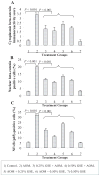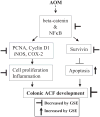Dietary-feeding of grape seed extract prevents azoxymethane-induced colonic aberrant crypt foci formation in fischer 344 rats
- PMID: 20564341
- PMCID: PMC2892197
- DOI: 10.1002/mc.20643
Dietary-feeding of grape seed extract prevents azoxymethane-induced colonic aberrant crypt foci formation in fischer 344 rats
Abstract
Chemoprevention by dietary agents/supplements has emerged as a novel approach to control various malignancies, including colorectal cancer (CRC). This study assessed dietary grape seed extract (GSE) effectiveness in preventing azoxymethane (AOM)-induced aberrant crypt foci (ACF) formation and associated mechanisms in Fischer 344 rats. Six-week-old rats were injected with AOM, and fed control diet or the one supplemented with 0.25% or 0.5% (w/w) GSE in pre- and post-AOM or only post-AOM experimental protocols. At 16 wk of age, rats were sacrificed and colons were evaluated for ACF formation followed by cell proliferation, apoptosis, and molecular analyses by immunohistochemistry. GSE-feeding caused strong chemopreventive efficacy against AOM-induced ACF formation in terms of up to 60% (P < 0.001) reduction in number of ACF and 66% (P < 0.001) reduction in crypt multiplicity. Mechanistic studies showed that GSE-feeding inhibited AOM-induced cell proliferation but enhanced apoptosis in colon including ACF, together with a strong decrease in cyclin D1, COX-2, iNOS, and survivin levels. Additional studies showed that GSE-feeding also decreased AOM-caused increase in beta-catenin and NF-kappaB levels in colon tissues. Compared to control animals, GSE alone treatment did not show any considerable change in these biological and molecular events in colon, and was nontoxic. Together, these findings show the chemopreventive efficacy of GSE against the early steps of colon carcinogenesis in rats via likely targeting of beta-catenin and NF-kappaB signaling, and suggest its potential usefulness for the prevention of human CRC.
Figures





Similar articles
-
Grape seed extract efficacy against azoxymethane-induced colon tumorigenesis in A/J mice: interlinking miRNA with cytokine signaling and inflammation.Cancer Prev Res (Phila). 2013 Jul;6(7):625-33. doi: 10.1158/1940-6207.CAPR-13-0053. Epub 2013 May 2. Cancer Prev Res (Phila). 2013. PMID: 23639480 Free PMC article.
-
Inhibition of azoxymethane-induced colonic aberrant crypt foci formation by silibinin in male Fisher 344 rats.Cancer Prev Res (Phila). 2008 Oct;1(5):376-84. doi: 10.1158/1940-6207.CAPR-08-0059. Cancer Prev Res (Phila). 2008. PMID: 19138982 Free PMC article.
-
Chemopreventive properties of a selective inducible nitric oxide synthase inhibitor in colon carcinogenesis, administered alone or in combination with celecoxib, a selective cyclooxygenase-2 inhibitor.Cancer Res. 2002 Jan 1;62(1):165-70. Cancer Res. 2002. PMID: 11782374
-
Prevention of colon cancer and modulation of aberrant crypt foci, cell proliferation, and apoptosis by retinoids and NSAIDs.Adv Exp Med Biol. 1999;470:55-63. doi: 10.1007/978-1-4615-4149-3_6. Adv Exp Med Biol. 1999. PMID: 10709674 Review.
-
Gene mutations and altered gene expression in azoxymethane-induced colon carcinogenesis in rodents.Cancer Sci. 2004 Jun;95(6):475-80. doi: 10.1111/j.1349-7006.2004.tb03235.x. Cancer Sci. 2004. PMID: 15182426 Free PMC article. Review.
Cited by
-
The chemopotential effect of Annona muricata leaves against azoxymethane-induced colonic aberrant crypt foci in rats and the apoptotic effect of Acetogenin Annomuricin E in HT-29 cells: a bioassay-guided approach.PLoS One. 2015 Apr 10;10(4):e0122288. doi: 10.1371/journal.pone.0122288. eCollection 2015. PLoS One. 2015. PMID: 25860620 Free PMC article.
-
Dietary grape seed extract ameliorates symptoms of inflammatory bowel disease in IL10-deficient mice.Mol Nutr Food Res. 2013 Dec;57(12):2253-7. doi: 10.1002/mnfr.201300146. Epub 2013 Aug 21. Mol Nutr Food Res. 2013. PMID: 23963706 Free PMC article.
-
Chemoprevention of Colonic Aberrant Crypt Foci by Novel Schiff Based Dichlorido(4-Methoxy-2-{[2-(Piperazin-4-Ium-1-Yl)Ethyl]Iminomethyl}Phenolate)Cd Complex in Azoxymethane-Induced Colorectal Cancer in Rats.Sci Rep. 2015 Jul 23;5:12379. doi: 10.1038/srep12379. Sci Rep. 2015. PMID: 26201720 Free PMC article.
-
Grape polyphenols inhibit Akt/mammalian target of rapamycin signaling and potentiate the effects of gefitinib in breast cancer.Nutr Cancer. 2012;64(7):1058-69. doi: 10.1080/01635581.2012.716898. Nutr Cancer. 2012. PMID: 23061908 Free PMC article.
-
Oxidative stress and food supplementation with antioxidants in therapy dogs.Can J Vet Res. 2017 Jul;81(3):206-216. Can J Vet Res. 2017. PMID: 28725111 Free PMC article. Clinical Trial.
References
-
- Huerta S. Recent advances in the molecular diagnosis and prognosis of colorectal cancer. Expert Rev Mol Diagn. 2008;8:277–288. - PubMed
-
- American Cancer Society. Colorectal cancer facts and figures. American Cancer Society; Atlanta, GA: 2009.
-
- Half E, Arber N. Colon cancer: preventive agents and the present status of chemoprevention. Expert Opin Pharmacother. 2009;10:211–219. - PubMed
-
- Veeriah S, Miene C, Habermann N, et al. Apple polyphenols modulate expression of selected genes related to toxicological defense and stress response in human colon adenoma cells. Int J Cancer. 2008;122:2647–2655. - PubMed
-
- Rudolf E, Andelova H, Cervinka M. Polyphenolic compounds in chemoprevention of colon cancer - targets and signaling pathways. Anticancer Agents Med Chem. 2007;7:559–575. - PubMed
Publication types
MeSH terms
Substances
Grants and funding
LinkOut - more resources
Full Text Sources
Medical
Research Materials

